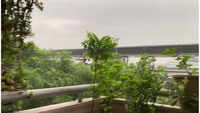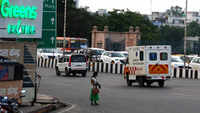
Nagpur: In the last two decades, Nagpur has lost green cover equivalent to nearly 7,500 football fields and 60 Seminary Hills reserve forests.
A first-of-its-kind study done by the Indian Space Research Organisation’s (ISRO) Regional Remote Sensing Centre (RRSC) reveals that between 1999-2018, the city’s green cover decreased by almost 30%. On the other hand, non-green cover including infrastructural development increased by 83% in a 25 kilometre range of Nagpur city.
‘Investigation on the decadal changes of green coverage in Nagpur region’, the scientific study analysed the green coverage using data obtained from satellites Landsat 7 and Landsat 8.
The study was reportedly carried out on a request by Nagpur’s honorary wildlife warden Jaydeep Das. While Alok Taori is the principal investigator, Arun Suryavanshi and AO Varghese are the co-investigators of the study.
Environmental activists of the city will be submitting the study to Nagpur Municipal Commissioner Abhijit Bangar soon. Upset over recent plans to fell more trees for infra projects, they have been making several representations to the authorities.
The study highlighted “drastic” depletion of green cover in South West Nagpur – the constituency of state chief minister Devendra Fadnavis. “Over the years, the city lost immense green cover in this region with the development of Mihan-SEZ, Butibori and other industrial areas,” says wildlife conservationist Prafulla Bhamburkar.
Satellite images in the study clearly show that infrastructural establishments have nearly doubled in the city while the green cover has constantly decreased. From 116 square kilometres in 1999, the city’s green cover within municipal limits went down to 76 square kilometres by 2018. As per the scientists, a major cause of concern is the percentage variation of green and infrastructural cover.
“Within the municipal limits, green cover decreased by 34% and infrastructural cover went up by 16%. Natural resources in the city are shrinking,” the report stated.
Images further highlight significant green loss in areas like Manish Nagar, Hudkeshwar, Besa, Narsala, Chinchbhuvan and surrounding areas. “The loss in these areas can be attributed to expansion of the city. Over the years, various residential and commercial layouts have come up here,” says Bhamburkar.
According to experts, the report clearly ascertains that compensatory plantations have been a big failure in the city. “As per the rules of Nagpur Municipal Corporation (NMC), compensatory afforestation is done in 1:5 ratio. If it was implemented effectively, the green cover should have increased rather than declined by 30%. Rapid urbanization and non-implementation of the Maharashtra (Urban Areas) Protection and Preservation of Trees Act, 2017, are the main reasons for depleting green cover,” said Kaustav Chatterjee, founder of NGO Green Vigil Foundation.
The scientists further compared the data of November 2018 with 1999 to find out the existing green cover. “There are few green patches within the city which are new. These might be a result of efforts taken by authorities,” the report stated.
However, the area of such patches is hardly about 11 square kilometre, while that of lost green cover is nearly 51 square kilometres. The area of existing green cover is 65.19 square kilometres.
Attributing climate change to “unbalanced development”, scientists have concluded that the ratio of developmental activities and green coverage as well as water resources need to be maintained in the city. “The imbalance leads to various long-term effects like creation of isolated heat regions and rise in air pollution,” they stated.
Stating that a large number of age-old trees are being rapidly destroyed for road widening or construction in many areas, Das said, “We need to treat urban green as an infrastructure and not an obstruction to the so-called development that is taking place in the city. It is because of this massive green loss that we are facing severe crisis like water scarcity, air pollution, reducing groundwater levels, increasing temperatures and delayed monsoon. When making city’s development plans, the authorities can’t segregate development of infrastructure and preserving green heritage.”
Pointing out that NMC has failed in carrying out tree census since 2010, Chatterjee said, “It is mandatory to conduct the census every five years. Even public hearings are not being conducted despite massive objections filed in cases like tree felling in Bharat Van and Empress Mills. While the civic body is not following laws relevant to preservation of green cover, citizens also need to realize that tree plantation campaigns are mostly non-scientific social media oriented. Hence, there is hardly any impact on green cover of the city.”
A first-of-its-kind study done by the Indian Space Research Organisation’s (ISRO) Regional Remote Sensing Centre (RRSC) reveals that between 1999-2018, the city’s green cover decreased by almost 30%. On the other hand, non-green cover including infrastructural development increased by 83% in a 25 kilometre range of Nagpur city.
‘Investigation on the decadal changes of green coverage in Nagpur region’, the scientific study analysed the green coverage using data obtained from satellites Landsat 7 and Landsat 8.
The study was reportedly carried out on a request by Nagpur’s honorary wildlife warden Jaydeep Das. While Alok Taori is the principal investigator, Arun Suryavanshi and AO Varghese are the co-investigators of the study.
Environmental activists of the city will be submitting the study to Nagpur Municipal Commissioner Abhijit Bangar soon. Upset over recent plans to fell more trees for infra projects, they have been making several representations to the authorities.
The study highlighted “drastic” depletion of green cover in South West Nagpur – the constituency of state chief minister Devendra Fadnavis. “Over the years, the city lost immense green cover in this region with the development of Mihan-SEZ, Butibori and other industrial areas,” says wildlife conservationist Prafulla Bhamburkar.
Satellite images in the study clearly show that infrastructural establishments have nearly doubled in the city while the green cover has constantly decreased. From 116 square kilometres in 1999, the city’s green cover within municipal limits went down to 76 square kilometres by 2018. As per the scientists, a major cause of concern is the percentage variation of green and infrastructural cover.
“Within the municipal limits, green cover decreased by 34% and infrastructural cover went up by 16%. Natural resources in the city are shrinking,” the report stated.
Images further highlight significant green loss in areas like Manish Nagar, Hudkeshwar, Besa, Narsala, Chinchbhuvan and surrounding areas. “The loss in these areas can be attributed to expansion of the city. Over the years, various residential and commercial layouts have come up here,” says Bhamburkar.
According to experts, the report clearly ascertains that compensatory plantations have been a big failure in the city. “As per the rules of Nagpur Municipal Corporation (NMC), compensatory afforestation is done in 1:5 ratio. If it was implemented effectively, the green cover should have increased rather than declined by 30%. Rapid urbanization and non-implementation of the Maharashtra (Urban Areas) Protection and Preservation of Trees Act, 2017, are the main reasons for depleting green cover,” said Kaustav Chatterjee, founder of NGO Green Vigil Foundation.
The scientists further compared the data of November 2018 with 1999 to find out the existing green cover. “There are few green patches within the city which are new. These might be a result of efforts taken by authorities,” the report stated.
However, the area of such patches is hardly about 11 square kilometre, while that of lost green cover is nearly 51 square kilometres. The area of existing green cover is 65.19 square kilometres.
Attributing climate change to “unbalanced development”, scientists have concluded that the ratio of developmental activities and green coverage as well as water resources need to be maintained in the city. “The imbalance leads to various long-term effects like creation of isolated heat regions and rise in air pollution,” they stated.
Stating that a large number of age-old trees are being rapidly destroyed for road widening or construction in many areas, Das said, “We need to treat urban green as an infrastructure and not an obstruction to the so-called development that is taking place in the city. It is because of this massive green loss that we are facing severe crisis like water scarcity, air pollution, reducing groundwater levels, increasing temperatures and delayed monsoon. When making city’s development plans, the authorities can’t segregate development of infrastructure and preserving green heritage.”
Pointing out that NMC has failed in carrying out tree census since 2010, Chatterjee said, “It is mandatory to conduct the census every five years. Even public hearings are not being conducted despite massive objections filed in cases like tree felling in Bharat Van and Empress Mills. While the civic body is not following laws relevant to preservation of green cover, citizens also need to realize that tree plantation campaigns are mostly non-scientific social media oriented. Hence, there is hardly any impact on green cover of the city.”
Trending Topics
LATEST VIDEOS
More from TOI
Navbharat Times
Featured Today in Travel
Quick Links
Lok Sabha Election Schedule 2019Lok Sabha Election NewsDelhi Capitals teamMI team 2019Rajasthan Royals 2019RCB team 2019Maharashtra Lok Sabha ConstituenciesBJP Candidate ListBJP List 2019 TamilnaduShiv Sena List 2019AP BJP List 2019Mamata BanerjeeBJP List 2019 MaharashtraPriyanka GandhiBJP List 2019 KarnatakaAMMK Candidate List 2019BJP List 2019 WBLok Sabha Elections in Tamil NaduBSP List 2019 UPNews in TamilLok Sabha Poll 2019Satta Matka 2018PM ModiMahagathbandhanNagpur BJP Candidate ListChandrababu NaiduTamil Nadu ElectionsUrmila MatondkarNews in TeluguMadras High CourtTejashwi YadavArvind KejriwalTejasvi SuryaPawan KalyanArvind KejriwalYogi AdityanathJaya PradaSatta King 2019Srinagar encounter
Get the app







